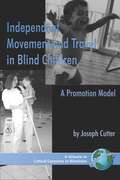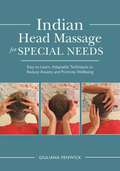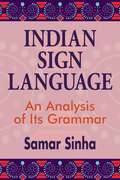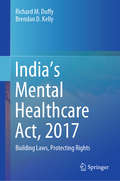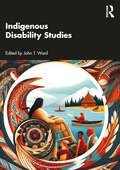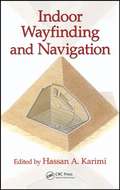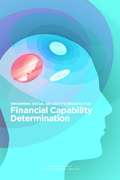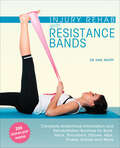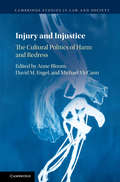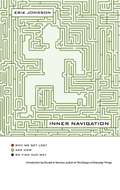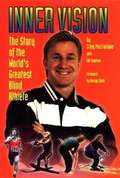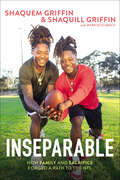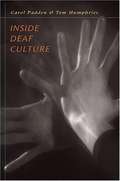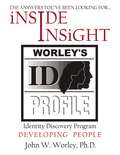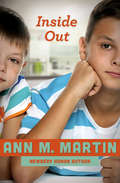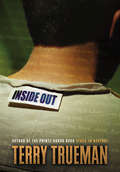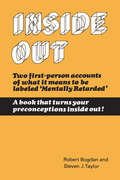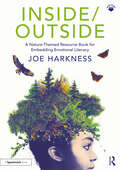- Table View
- List View
Independent Living: A Curriculum With Adaptations for Students With Visual Impairments, Vol. 3
by Nancy Levack Robin Loumiet Brigitte MaGeeIndependent Living Volume III: Play and Leisure 2nd Edition Texas School for the Blind and Visually Impaired
Independent Living: Assessment & Ongoing Evaluation for Independent Living
by Texas School for the Blind and Visually ImpairedAssessment & Ongoing Evaluation for Independent Living <P><P> A Curriculum with Adaptations for Students with Visual Impairments
Independent Living: Volume I: Social Competence
by Nancy Levack Robin LoumietA Curriculum with Adaptation for Students with Visual Impairments. This bestseller will help you in assessing, teaching, and evaluating students from school age to adulthood who will live independently or with minimal assistance in social, self-care, and leisure skills.
Independent Living: Volume II: Self-Care and Maintenance of Personal Environment
by Nancy Levack Robin LoumietA Curriculum with Adaptation for Students with Visual Impairments. This bestseller will help you in assessing, teaching, and evaluating students from school age to adulthood who will live independently or with minimal assistance in social, self-care, and leisure skills.
Independent Movement and Travel in Blind Children: A Promotion Model
by Joseph CutterAn innovative guide to encouraging activity, movement, and independence in the young blind child and full of creative ideas, this book provides guidance for parents, teachers, instructional assistants, physical therapists, teachers of the blind, and O&M instructors who desire to create a learning environment in which the blind child can become curious, involved, active and independent.
Indian Head Massage for Special Needs: Easy-to-Learn, Adaptable Techniques to Reduce Anxiety and Promote Wellbeing
by Giuliana FenwickThis complete manual introduces unique Indian head massage techniques to help reduce feelings of stress and anxiety, calm sensory overloads, improve sleep patterns, ease frustration and boost mental, physical and emotional wellbeing in people of all ages with special needs, including Autism Spectrum Disorders. The book provides everything you need to get started, including: - A full, step-by-step, illustrated massage routine - Essential tips on how to create the perfect environment and how to approach clients with special needs - Detailed case studies - Information on anatomy, physiology and the complementary approaches to the body - Supplementary information on essential oils Developed by Giuliana Fenwick through work with her son, and extensively trialled in schools and specialist colleges, this tailored Indian head massage is perfect for anyone looking to provide additional support to people with special needs, including parents and carers, teachers, teaching assistants and other school staff, complementary therapists and any other professionals working with people with special needs.
Indian Sign Language: An Analysis of Its Grammar
by Samar SinhaSamar Sinha presents pioneering research into the grammatical properties of Indian Sign Language (ISL), a language used by members of the Deaf community in India. This detailed and well-illustrated study describes the grammar of ISL and is supplemented by comparative and theoretical analyses in the core areas of sublexical structure, morphology, and syntax. Sinha offers a field-based, comprehensive analysis that covers topics such as o sign formation parameters o syllable structure o sonority hierarchy o semantics of space o pluralization strategies o phi-features o indexing and localization o agreement o word order He provides a description of the Indian Deaf community that serves to frame his analysis of ISL and highlights the need for greater awareness and acknowledgment of the language and its users. The lack of research on ISL in Indian academia has slowed efforts toward the standardization of ISL and the development of pedagogical materials. This work adds to the growing understanding of natural human language in general and ISL in particular. It also contributes to the empowerment of the Deaf community in India and will strengthen the efforts carried out by d/Deaf activists and researchers.
India’s Mental Healthcare Act, 2017: Building Laws, Protecting Rights
by Brendan D. Kelly Richard M. DuffyThis book comprehensively discusses the background to the passing of India's revolutionary Mental Healthcare Act, 2017, offering a detailed description of the Act itself and a rigorous analysis in the context of the CRPD and the World Health Organization (WHO) standards for mental health law. It examines the fine balance, between complying with the CRPD while still delivering practical, humane, and implementable legislation. It explores how this legislation was shaped by the WHO standards and provides insights into areas where the Indian legislators deviated from these guidelines and why. Taking India as an example, it highlights what is possible in other low- and middle-income countries. Further it covers key issues in mental health, identifying potential competing interests and exploring the difficulties and limitations of international guidelines.The book is a valuable resource for psychiatrists, nurses, social workers, non-governmental organizations and all mental healthcare workers in India and anyone studying human rights law.
Indigenous Disability Studies
by John T. WardThis book provides a comprehensive approach to the perspectives, lived experiences, and socio-cultural beliefs of Indigenous scholars regarding disabilities through a distinctions-based approach. Indigenous people demonstrate considerable knowledge in a multitude of capacities in spite of legal, monetary, social, economic, health, and political inequalities that they experience within from administrative authorities whether health, education, or governments.By including various knowledge systems related to social-cultural, traditional governance, spirituality, educational, and self-representation within a communal understanding, the knowledge brought forth will be a combination of information from within/communal and outwards/infusion by Indigenous teachers, scholars, academics, and professionals who aim to combat the negative effects of disability labels and policies that have regulated Indigenous peoples.Comprised of five sections: The power, wisdom, knowledge, and lived experiences of Elders Reframing the narrative – Navigating self-representation Learning from within – Including traditional knowledge Challenging colonial authority – Infusing regional ideals and concepts Interpretations, narratives, and lived experiences of grassroots teachers and social service providers It will be an asset to those who seek out a deeper understanding of the complexity of Indigenous people and their knowledge, including anyone who deals with predominantly non-Indigenous mindsets and barriers to education.Courses on disability studies, Indigenous studies, social work, health, education, and development studies will all benefit from this book.
Individuals with Disabilities Education Improvement Act of 2004
by 108th CongressIndividuals with Disabilities Education Improvement Act of 2004.
Indoor Wayfinding And Navigation
by Hassan A. KarimiIndoor Wayfinding and Navigation provides both breadth and depth of knowledge in designing and building indoor wayfinding and navigation systems and services. It covers the types of sensors both feasible and practical for localization of users inside buildings. The book discusses current approaches, techniques, and technologies for addressing issues in indoor wayfinding and navigation systems and services. It includes coverage of the cognitive, positioning, mapping, and application perspectives, an unusual but useful combination of information. This mix of different perspectives helps you better understand the issues and challenges of building indoor wayfinding and navigation systems and services, how they are different from those used outdoors, and how they can be used efficiently and effectively in challenging applications. Written by well-known specialists in the field, the book addresses all aspects of indoor wayfinding and navigation. It includes the latest research developments on the topic, succinctly covers the fundamentals, and details the issues and challenges in building new systems and services. With this information, you can design indoor wayfinding and navigation systems and services for a variety of uses and users.
Informing Social Security’s Process for Financial Capability Determination
by Engineering Medicine National Academies of SciencesThe U.S. Social Security Administration (SSA) provides benefits to disabled adults and children, offering vital financial support to more than 19 million disabled Americans. Of that group, approximately 5.5 million have been deemed – by virtue of youth or mental or physical impairment - incapable of managing or directing the management of their benefits. Hence, a representative payee has been appointed to receive and disburse SSA payments for these beneficiaries to ensure that their basic needs for shelter, food, and clothing are met. Periodically, however, concerns have been expressed about the accuracy of the process by which SSA determines whether beneficiaries are capable of managing their benefits, with some evidence suggesting that underdetection of incapable recipients may be a particular problem. The importance of creating as accurate a process as possible for incapability determinations is underscored by the consequences of incorrectly identifying recipients either as incapable when they can manage their benefits or as capable when they cannot. Failure to identify beneficiaries who are incapable of managing their funds means abandoning a vulnerable population to potential homelessness, hunger, and disease. Informing Social Security’s Process for Financial Capability Determination considers capability determination processes used by other similar benefit programs, abilities required to manage, and direct the management of, benefits, and effective methods and measures for assessing capability. This report evaluates SSA’s capability determination process for adult beneficiaries and provides recommendations for improving the accuracy and efficiency of the agency’s policy and procedures for making these determinations.
Injury Rehab with Resistance Bands: Complete Anatomy and Rehabilitation Programs for Back, Neck, Shoulders, Elbows, Hips, Knees, Ankles and More
by Dr. Karl KnopfDiscover the power of resistance bands in rehabilitating injuries and strengthening the body through low-impact workouts complete with step-by-step photos.Ranging in intensity from super easy to extremely hard, the resistance band exercises in this book are sure to effectively and safely help you overcome any injury by building up strength and stability over time. Each section of the book by Dr. Karl Knopf targets a specific body part, with detailed anatomical information and easy-to-follow recovery routines for:NeckShouldersElbowsWrists & HandsLower BackHipsKneesAnkles & FeetWhether you’re looking to reduce pain, transform troublesome muscles, or get back in the game, Injury Rehab with Resistance Bands provides rehab techniques for your exact injury, including:Arthritis & TendinitisBursitis & FasciitisLigament & Meniscus InjuriesSprains & StrainsCarpal Tunnel SyndromeRotator Cuff Injuries
Injury and Injustice: The Cultural Politics of Harm and Redress (Cambridge Studies in Law and Society)
by David M. Engel Anne Bloom Michael McCannThis book addresses some of the most difficult and important debates over injury and law now taking place in societies around the world. The essays tackle the inescapable experience of injury and its implications for social inequality in different cultural settings. Topics include the tension between physical and reputational injuries, the construction of human injuries versus injuries to non-human life, virtual injuries, the normalization and infliction of injuries on vulnerable victims, the question of reparations for slavery, and the paradoxical degradation of victims through legal actions meant to compensate them for their disabilities. Authors include social theorists, social scientists and legal scholars, and the subject matter extends to the Middle East and Asia, as well as North America.
Inky: The Seeing Eye Dog
by Elizabeth P. HeppnerMore than anything in the world, Jonathan wants a dog. Then he finds a frisky puppy in the woods. But Inky already has an owner--the Seeing Eye. Jonathan is crushed until the man who has come for Inky asks, "Jonathan, how would you like to take care of Inky for the next twelve months?"
Inner Navigation
by Erik JonssonA fascinating investigation of how we navigate the physical world, "Inner Imagination is a lively, engaging account of subconscious map-making. Why are we so often disoriented when we come up from the subway? Do we really walk in circles when we lose our bearings in the wilderness?How -- and why -- do we get lost at all? In this surprising, stimulating book, Erik Jonsson, a Swedish-born engineer who has spent a lifetime exploring navigation over every terrain, from the crowded cities of Europe to the emptiness of the desert, gives readers extraordinary new insights into the human way-finding system. Written for the non-scientist, "Inner Navigation" explains the astonishing array of physical and psychological cues the brain uses to situate us in space and build its "cognitive maps" -- the subconscious maps it employs to organize landmarks. Humans, Jonsson explains, also possess an intuitive direction frame -- an internal compass -- that keeps these maps oriented (when it functions properly) and a dead-reckoning system that constantly updates our location on the map as we move through the world.
Inner Views from My Culture
by Audrey AbellAuthors Introduction: I wrote this book because my High School requires everyone to do a senior project to graduate. I decided to interview other teenagers and young people I know that have a disability because I have cerebral palsy and have had it my whole life. I'm hoping this book will help to raise awareness for those that are not disabled by helping them to understand what we go through day to day in the life of a young person with CP. I wanted it to be from the strong heart of my generation. I collected the information by email, in person and phone conversations that were recorded. For the interviews I asked everyone forty-one questions and they answered only the ones they wanted to. Each person has his or her own chapter. It ended up that the majority of everyone in this book has cerebral palsy of some kind. Some of the people I knew already and some I found by word of mouth and on the internet. The questions I asked my friends were inspired by my own life and what I deal with on a daily basis. The people who participated in this book chose to be anonymous because some of the questions are very personal and that way it could be private. Everyone who contributed to the book will get their own copy to share with whomever they want, in their lives and communities. Hopefully after people read the information it will give them more insight and they'll have more understanding. Like most people in the book I am the only one at my school in a power chair and that has cp. I've been the only one my whole life so I'm used to that. I think my being at school has made some people more aware. I think the problem is that people don't understand those with disabilities have the same feelings and think the same. When someone does "get it" they just treat me like a normal person, speak directly to me normally, without extra loudness or slowness or the other big one is they don't talk to me like I'm a baby. In the interview I talk about other important issues. I hope you enjoy this book and that it changes your perspective on us, our world, and our culture. I also hope that it helps all the young writers who participated, feel better to know about what each other is going through and that we share a lot of the same feelings and can learn and help each other. That goes for people with disabilities everywhere too.
Inner Vision: The Story of the World's Greatest Blind Athlete
by Craig Macfarlane Gib TwymanCraig MacFarlane lost his sight at age 2 and went on to become not only the world's greatest blind athlete, but a much-sought-after motivational speaker. His message is PRIDE -- Perseverance, Respect, Individuality, Desire and Enthusiasm.
Inseparable: How Family and Sacrifice Forged a Path to the NFL
by Mark Schlabach Shaquem Griffin Shaquill GriffinMuch more than a sports memoir, in Inseparable Shaquem and Shaquill Griffin share the previously untold details of the powerful and inspiring story behind the modern NFL&’s first one-handed player, and his twin brother&’s unrelenting devotion, sacrifice, and love. It&’s the story of Shaquem&’s understanding of God&’s purpose for his life—to inspire others to stop being afraid and to stop making excuses—and his family&’s unwavering support in spite of seemingly insurmountable obstacles. The Griffins&’ unlikely underdog story has already captured the imagination of millions of football fans and physically challenged people around the world.
Inside Deaf Culture
by Tom Humphries Carol Padden<P>In this [account] of the changing life of a community, the authors of Deaf in America reveal historical events and forces that have shaped the ways that Deaf people define themselves today. Inside Deaf Culture relates Deaf people's search for a voice of their own, and their proud self-discovery and self description as a flourishing culture. <P>Padden and Humphries show how the nineteenth-century schools for the deaf, with their denigration of sign language and their insistence on oralist teaching, shaped the lives of Deaf people for generations to come. They describe how Deaf culture and art thrived in mid-twentieth-century Deaf clubs and Deaf theater, and they profile controversial contemporary technologies. <P> Most triumphant is the story of the survival of the rich and complex American Sign Language long misunderstood but finally recognized by a hearing world that could not conceive of language in a form other than speech. In a moving conclusion, the authors describe their own very different pathways into the Deaf culture, and reveal the confidence and the anxiety of the people of this tenuous community as it faces the future.
Inside Insight: Worley's Identity Discovery Profile (WIDP)
by John WorleyWho are you? Wouldn't you like to be authentic?&“INSIDE INSIGHT!&” By the time you finish reading this book, YOU will be a NEW PERSON!Most people have no idea what they want. Then again, for that matter, who they are. That is causing a world of hurt.The outcome from Dr. Worley is a ground-breaking psychometric assessment, Worley&’s ID Profile (WIDP). WIDP used with overwhelmingly positive reviews by corporate leaders, HR Departments, clinicians, churches, schools, sports teams, families, and individuals.In this book, Dr. Worley speaks about how he developed WIDP, why it is radically different from other profiling systems, and how you can use it to help align your outer persona and behavior with your inner expectations. WIDP concretely identifies what you "prefer and do not prefer from others.&” This crucial proof will help enhance your quality of life, and "You will see yourself on the pages of your profile.&”Having completed thousands of profiles I ALWAYS get responses like, &“WOW, how can you get this much information from those questions?&” or &“I can&’t believe how accurate this is about me!&” or &“I wish I had this information when I was younger!&” or &“I want to profile my whole family.&”Let&’s say you are one of those individuals that have always felt uncomfortable being around many people and don&’t like to socialize. GUESS WHAT? Most of society is like that! That is why no one talks on elevators or in doctor&’s offices. It just happens to be your unique temperament. It is &“OK&” for you to feel that way because that is who you are so, leave yourself alone and enjoy the recluse life. You are one of those people who live in their head, thinking, creating, dreaming and inventing ideas. Most people go through life not being able to identify with their true inner desires. You are one of a kind, unique person and that makes you very special.Then there is the temperament that has the innate desire always to be leading others, making decisions, and being in control. They are natural-born leaders and, like cream in milk, will always rise to the top of an organization. You are naturally gifted as a leader and have innate ability to lead armies. If you cannot lead where you are, you will move to another position. You will be anxious until you land in a governance spot. Once you find that position, you will be fulfilled.Then there are the peacemakers, servants, and cheerleaders! The peacemakers balance out everyone and maintain harmony. They are great arbitrators and have a comedy streak. The servants are loyal and committed to working until the task is completed. They are proficient and quiet. They are invaluable. The cheerleaders are the socialites who make the world exciting and fun. Without them, life would be boring. We need them, and they want all of us to be open to them and to be their friends. They are very colorful and expressive and, very open in their communications.We&’re different! Appreciate your temperament. You are VERY important!Expect miracles.
Inside Out
by Ann M. MartinHow do you love someone who makes you miserable? Eleven-year-old Jonathan just wants to have a normal life—for instance, a night when he isn&’t awakened by screams, or a day when he&’s not teased by other kids for having a disabled family member. But normal can&’t happen when your little brother is severely autistic.James, Jonathan&’s four-year-old brother, needs more help than his parents can give him. And it&’s not just hard for Jonathan—it&’s causing strife for the whole family. When James gets into a special school for autistic children, Jonathan and his sister have to make a lot of sacrifices so he can go. Jonathan comes up with an idea to help out the family—but will his plan work, or only lead to more teasing?This ebook features an illustrated personal history of Ann M. Martin, including rare images from the author&’s collection.
Inside Out
by Terry TruemanIn a busy coffee shop, a robbery goes wrong. Two gunmen hold seven hostages, including teenager Zach Wahhsted. What nobody realizes at first is that Zach is anything but ordinary and his troubled mind is more dangerous than any weapon. Terry Trueman has created a compelling character with the same shocking power and heartbreaking compassion as his Printz Honor Award debut novel, Stuck in Neutral. Ages 12+
Inside Out: The Social Meaning of Mental Retardation
by Steven J. Taylor Robert Bogdan Seymour B. Sarason'We have to assume that the mind is working no matter what it looks like on the outside. We can't just judge by appearance...If you take away the label they are human beings.' Ed MurphyWhat does it mean to be 'mentally retarded'? Professors Bogdan and Taylor have interviewed two experts, 'Ed Murphy' and 'Pattie Burt,' for answers. Ed and Pattie, former inmates of institutions for the retarded, tell us in their own words.Their autobiographies are not always pleasant reading. They describe the physical, mental, and emotional abuses heaped upon them throughout their youth and young adulthood; being spurned, neglected, and ultimately abandoned by family and friends; being labelled and stigmatized by social service professionals armed with tests and preconceptions; being incarcerated and depersonalized by the state.Ed and Pattie survived these experiences--evidence, perhaps, of the indefatigable will of the human spirit to assert its essential humanity--but the wounds they have suffered, and the scars they bear, have not been overcome. They are now contributing, independent, members of society, but the stigma of 'mental retardation' remains.Their stories are both true and representative--powerful indictments of our knowledge of, our thinking about, and our ministrations to, the mentally handicapped. The interviewers argue that Ed and Pattie challenge the very concept of 'mental retardation.' Retardation, they assert, is an 'imaginary disease'; our attempts to 'cure' it are a hoax.Read Ed's and Pattie's accounts and judge for yourself.
Inside/Outside: A Nature-Themed Resource Book for Embedding Emotional Literacy
by Joe HarknessInside/Outside is a unique educational resource for those working with young people of secondary school age, providing a variety of tried-and-tested indoor and outdoor lessons and activities to promote and embed emotional literacy. The book is divided into three accessible sections: emotions and feelings; self and situation; and mental health and wellbeing; which each cover a variety of themes, from anxiety and depression, to happiness, communication, and confidence. For each theme, ‘inside’ and ‘outside’ activities are offered, with inside activities inspiring students to self-reflect and develop empathy for others, and those outside drawing heavily on nature and learning outside the classroom. The ‘outside’ activities are adaptable and have been designed to work in any available outdoor space, and all activities can be used either in standalone lessons or sequentially, with introductory tasks, group activities, and circle time discussions. With a focus on equipping students with meaningful and tangible skills to support them in the recognition, identification, and expression of their emotions, Inside/Outside will be a valuable resource for teachers, youth workers, home-educators and anyone else looking to facilitate nature connection and introspection in children aged eleven to sixteen.

